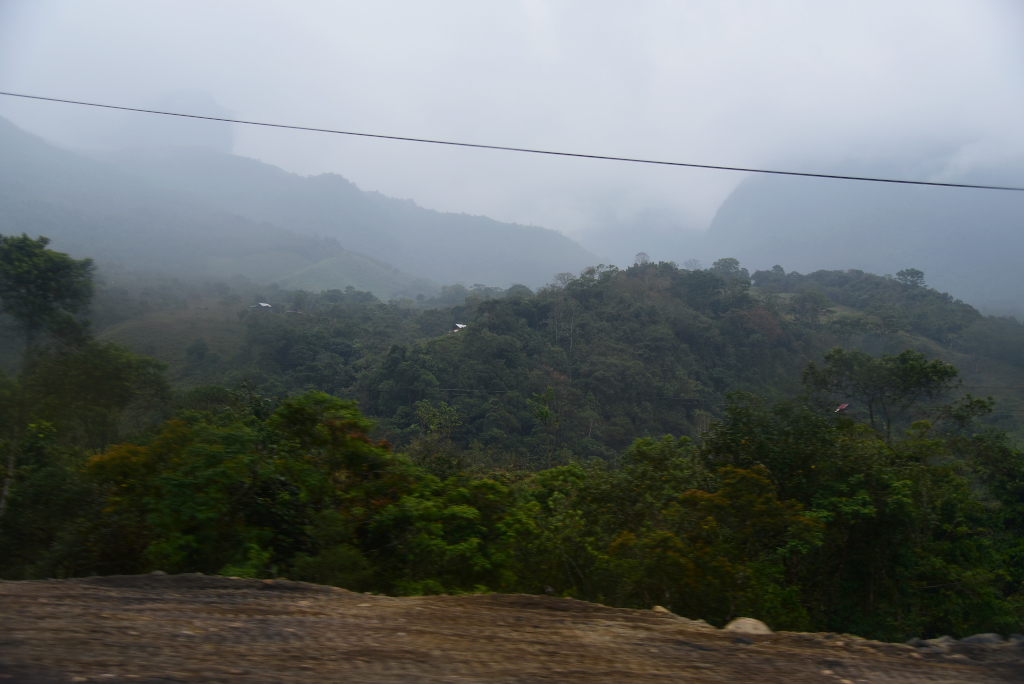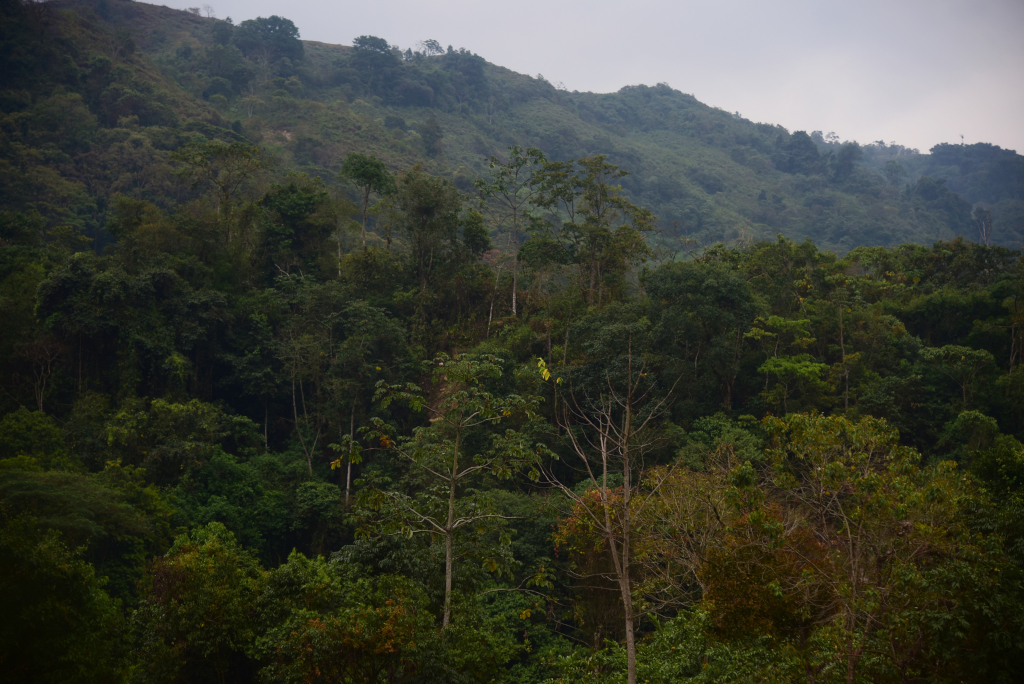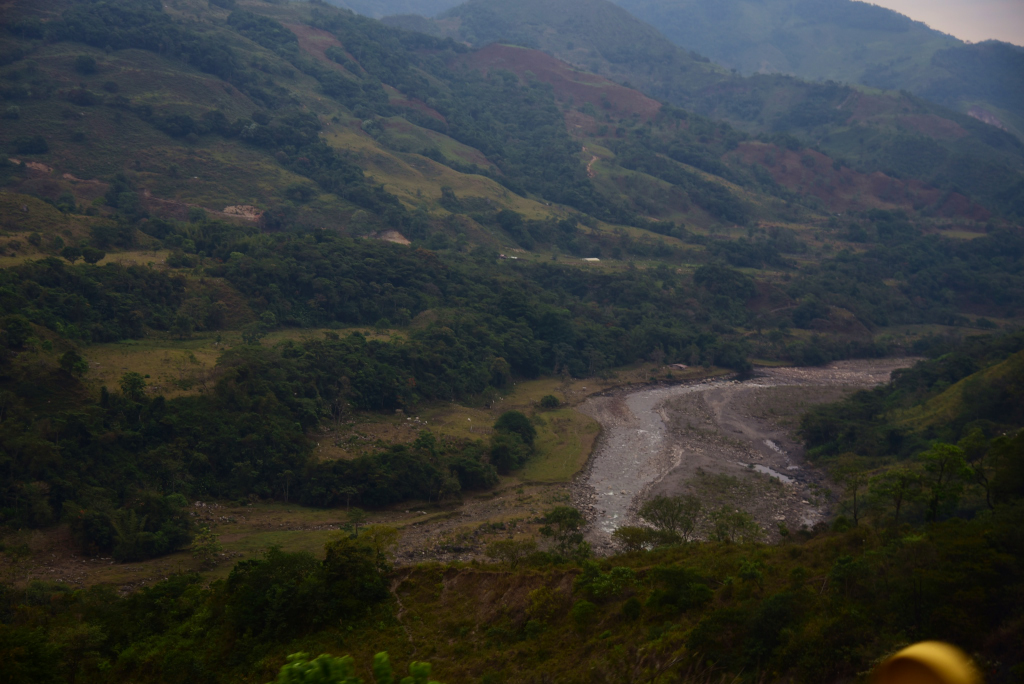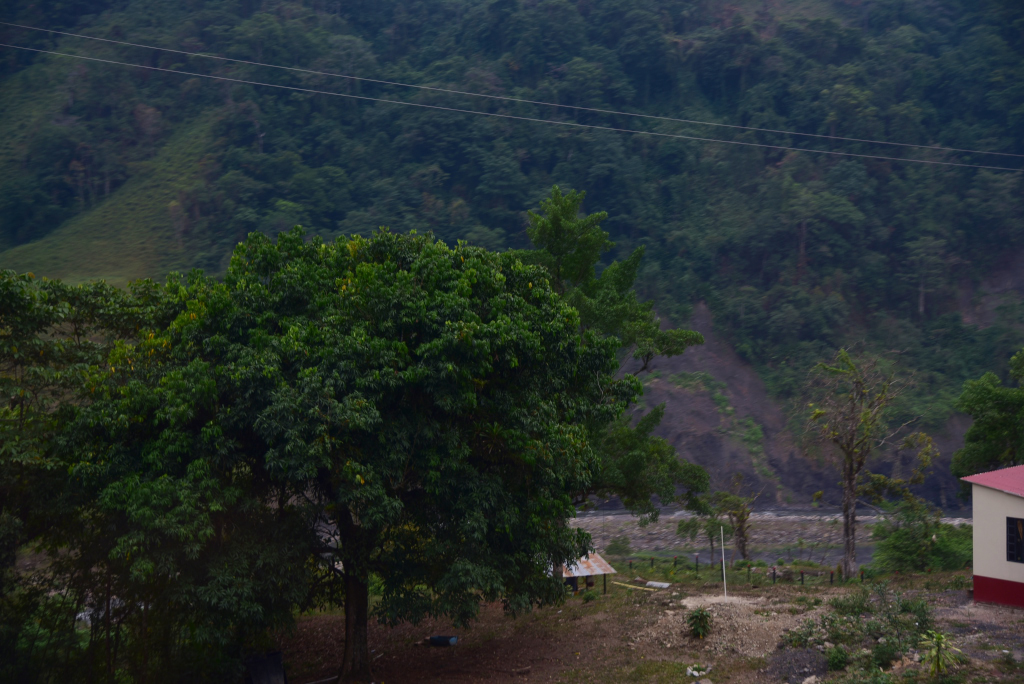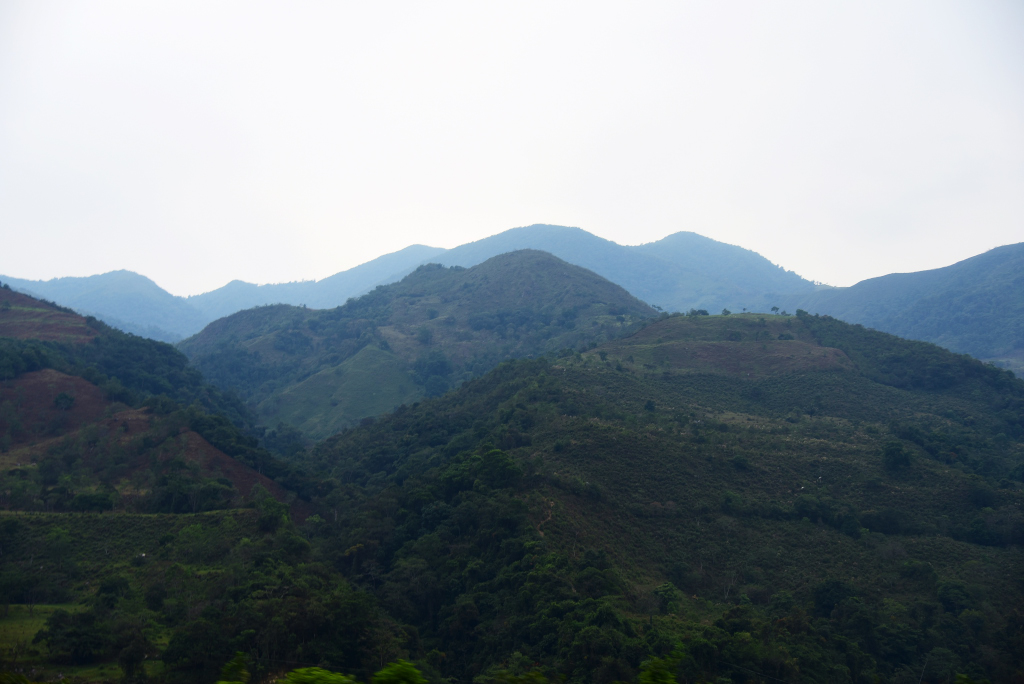March 1, 2018
Breakfast with the German group at the hotel, before our inevitable departure for the far beyond. Mediocre scrambled eggs, Antonio hunched over his magazine at the adjoining table, his cleaning assistant incredulous that I am dousing my egg dish with habanero salsa. He makes several half-hearted attempts to call the bus company for departure times to Sagamoso. Packing takes more time than expected, given how many things need to be shoved into just the right crevice in my packs. Since it is not clear how frequent the departures are, I decide to not return to the textile shop and buy any of the things I had set aside yesterday evening. If there are no buses beyond noon, I may be in serious trouble, not knowing anything about Yopal, my final destination today.
Now standing on the curb outside, a few trucks rumble by as well as a smattering of cyclists before Antonio himself ambles by on his own bike. He may be in up to his neck in the operation of his hotel, although it doesn’t feel as if his heart is in it. I am soon off to the next destination myself, my extended journey through Boyacá finally coming to a close. And yet, ambling along in the country bus past the rambling country residences, sprawling eateries and green pastureland towards Sagamoso, little do I realize how I compelled I am yet again to extending my stay in the departamento.
The return to Sagamoso is a far cry from the return to town two days ago, which involved onerous weaving through congested streets. Today, the driver passes through relatively sedate streets, avoiding busier streets and areas that are particularly run down. The mostly students stream off the bus well before the terminal, leaving the bus almost empty as we approach – but not enter – the terminal.
Back to civilization! Well, Sogamoso, anyway, and even though I shouldn’t dwell here too long. However, I want to visit the parque and see some familiar faces and places again, never mind consume a good coffee before embarking on a long and arduous bus ride to a very different part of the country. The agent at the Libertadores ticket booth is only too happy to let me leave my large backpack in his wicket while I hunt down that good coffee …
Heading south on Carrera 14 looks promising, but the coffee shop I saw from the bus is definitively closed. 14 represents another relatively busy street that I had not discovered in my prior stay in Sogamoso, but no, now is not the time. There are of course other possibilities, and that would include the Spazio Caffè. The owner’s mouth hangs open as I amble in, and of course we launch into another heated conversation. Her father arrives, a carpenter by profession who had decided to hand-build wooden canoes for a canoeing club with the intent of promoting canoeing on Lago de Tota, and ultimately raising awareness of freshwater ecology. And for assistance with the development of the canoes, they are meeting the Canadian ambassador to Colombia on the 13th. What a coincidence!
The sun is shining and it feels very good to be back in Sagamoso. The pasteles de pollo I am sold from a cubbyhole down the street are positively amazing. The streets are littered with fast food and fruit vendors, another good sign. However, I do have to return to the bus station – it would just be too easy to get stuck in Sagamoso. There is so much of the country I have yet to see, and time is running out …
Libertadores have not tossed my backpack, and the coach parked at the quay next to the office is leaving in 20 minutes, a good sign. I buy a back of the taralli-like rosquillas and relax in my seat, not quite sure what to expect on this journey. And no, it doesn’t unfold quite as expected.
We climb up to Lago de Tota, the thick cloud cover moving over the high elevation lake as the road weaves further up along the hillsides, the classic frigid pasture-dotted Boyacá terrain. The highway south branches off the lakeside road to Aquitania somewhere near the top of the lake, leaving only glimpses of the lake visible in the distance through the windows now coated in condensation. Munching through the collection of starchy cookies and crackers that I have amassed, I peer blithely into the growing early afternoon darkness, the bus weaving around the hillsides, now descending, even in the poor visibility the fecundity of the vegetation apparent.
Progress along the serpentine descent is brought to a virtual standstill with the onslaught of ungainly commercial transports on the serpentine mountain road and the endless roadwork taking place. What the highways here desperately need is passing lanes, but that will probably only happen far in the future, given how rudimentary these roads currently are.
Despite the blinding fog, it is apparent that the vegetation is changing rapidly upon our descent, palms, tree ferns, and flora of a more subtropical nature. Brilliantly coloured, exotic flowers I haven’t seen before erupt before us as we navigate from hairpin to hairpin turn. And the minimal visibility continues, the thick fog engulfing our environment, rendering the possibility of photos negligible.
At a lower elevation, the pea soup fog clears, but the sky is still gunmetal grey, and photos of the steep hillsides soaring around the coach dark with indiscernible detail. Then the light-filtering screen on the bus windows don’t help, either. From the lush jungle flowing down the hillsides to the more conventional cleared land and finca plots typical of much of Boyacá, and then further down, the slopes are again rich in seething sub-tropical fecundity.
It is not possible to open windows on the bus, but I can only imagine that the temperature has risen substantially from the frigid temperature around Lago de Tota. And yet is seems we haven’t travelled that far, the bulk of our time taken crawling behind tankers and flatbed trailers on hairpin turns under construction.
And then, gas flares appear above the tree canopy as we ease onto a straight road, and now we are finally heading to the llanura of Casanare. I cringe at the idea of all the natural gas being wasted, but onward we soldier, the land around us still gently hilly, the scruffy bush nondescript, and then at some distance, the small community of Agua Azul.
The layout of the town and type of buildings reveals a considerable difference with the region I just came from, with a rectilinear street pattern, low profile, single story houses, the centre of town lined with a procession of cafes and restaurants with outdoor terraces, expansive and yet intimate in nature. On the outskirts of town, a plethora of ramshackle crumbling lots, and yet closer to the centre, the buildings predictably look smarter, with an intact finish.
I could imagine spending a day or two here, becoming familiar with the small community of Agua Azul, but simply won’t, largely because spending too much time in small, inconsequential communities is how I have already wasted considerable amounts of time in Colombia, then am left struggling to determine what specific attractions may be found in said places.
The journey along the country highway to Yopal is shortened by the impassioned sales pitch of a man at the front of the bus hawking vitamin powder. The diatribe raises some questions, including how the contents of the alleged vitamin canisters would be vetted, if at all, and the reality that there may be a lot less need for such kind of thing if locals had healthier diets. But the time passes, and since we are on a straight highway with relatively unimpeded traffic, the modern housing developments and expansive commercial complexes soon appear on the outskirts of Yopal.
The highway running towards the Venezuelan border far to the east runs along the flank of the hills rising up to the north, the south side of the highway flat as a board. But rather than the expected cattle ranches of the llanura, the south side of the highway amounts to scattered houses, scrub forest and grassland. In any case, I would not expect the landscape to be that memorable, so my focus will be on the urban environment.
Yopal comes as a surprise, a sprawling affluent city set in the scrub leading to the southern hillsides of the Colombian altiplano. Based on a rectilinear pattern, streets are wide, mitigating the impact of congestion, and the businesses lining the streets tend to be modern, spacious, well-lit, generally very presentable, and there are lots of them. We drive some distance through the town towards the bus terminal, and along most of the route, the streets are lined with restaurants, even bars and clubs. Affluence is in the air here. I had been concerned as to the safety of the place, but seeing how wealthy the town appears, such concern would have to be misplaced.
Committing the ultimate taxi-related faux pas, I hail a cab at the gas station adjacent the bus terminal, not realizing that I took the wrong exit and hence missed the taxi bank. The swarthy llanero manning the wheel of the cab hails from a small town in the real llano, and tells me Yopal has gone downhill. Just look at this place, he waves at the imperfections of the public spaces was pass by. I may not understand everything he says, but I only see a city that is far more affluent than I have seen anywhere else in the country. So irrespective of what his sentiments are, he is obviously not in the worst place to survive here.
The Hotel el Atajo I have booked a room in is a somewhat surreal affair, the imposing residence far more ostentatious in initial appearance than I would be used to seeing in the cramped residences in the mountains to the north. The skeptical receptionist gives me the lay of the land, telling me what I can and can’t do, and while the price he quotes me is higher than indicated on the net, he also gives me a huge, three bed-room on the top floor of the building attached to a terrace that wraps around the entire building. The room is so large that the bathroom itself is the size of most of the hotel rooms I have been in. Welcome to Casanare: the departamento with space to move!
‘Don’t touch the other beds or I’ll charge you for them’ he warns me, and then don’t think about bringing any of those Venezuelan nenas here, either, although it seems that is precisely what he wants me to do. When he progresses to the subject of whether I like doing cocaine like all the travellers who come here, leering at me inquisitively, I think it would be best to give some vague answer and continue to my private suite, ensuring that the door is locked, although neither the lock on the door to the hallway, nor the lock on the patio door function very well.
I had thought the hotel would be located in some odd corner of town, away from all the action, but it is actually in the dead centre of town, which is located to the north of Yopal, by the river. I am told to simply walk to the east on Calle 10, and I will find whatever I want, although little do I realize how promising the area even further to the east will get. Closer to the hotel, the uneven sidewalk leads past small almacenes, grocery stores, droguerieas, restaurants, and even two Chinese restaurants, somewhat shocking for the virtually uniform culinary offering of Colombia.
It has been a long day, I am just exhausted, and have to lie down. I get up again to belatedly unpack my things. Perhaps it is the heat that is making me so exhausted. Perhaps the fact that I have been living off excess sugar and starch for the last few days, always something that is protracted when a lot of travel is involved. It’s not as if life is that hard, given that I have nothing more to do every day than go through the motions of visiting some attractions and taking care of the basics, then writing about them …













